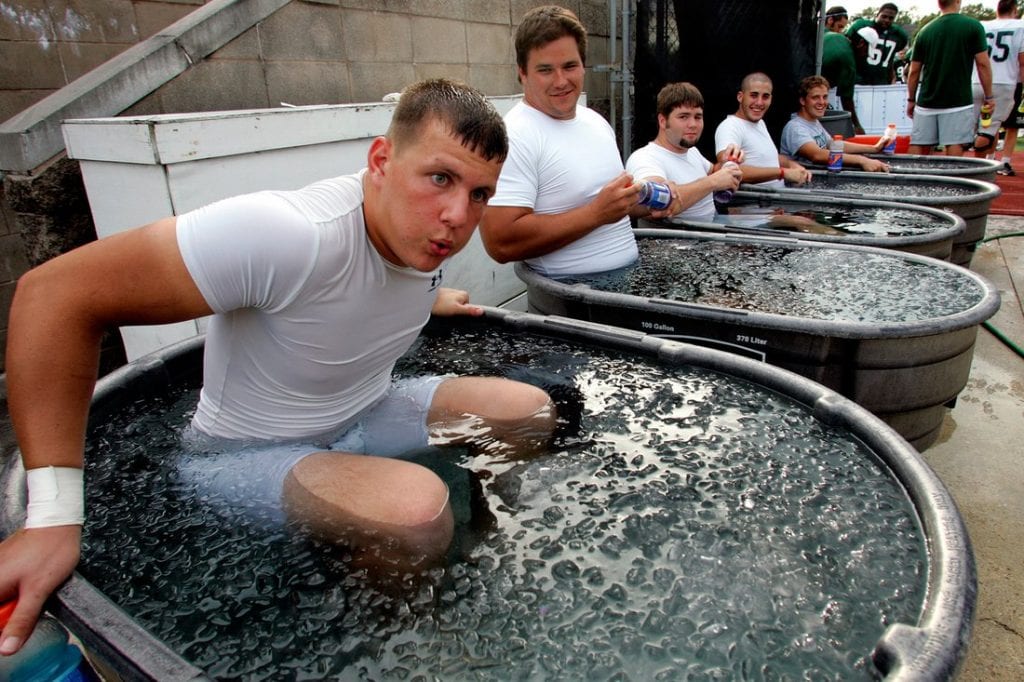By Kevin Masson MSc, CSCS, CPT, USAW, FMS
Rehabilitation for bicep and rotator cuff tendinopathy often involves several steps. These problems are most common in people who push themselves to the limits with lifting, either through powerlifting at the gym or lifting on the job.
Tendinopathy is most likely to occur when overloading them, either by using them too much injures the tendons or lifting too much weight with them. The tendon describes the connective fibers gathered together between your muscle and your bone. If you look at a picture of the musculoskeletal system, you will notice the muscles are made of red and white tissue. The red area is the meat of the muscle, and the white area is the tendon.
When an injury occurs, the body will work to heal the tendon. Sometimes, injuries will heal on their own. When a week or more passes, without definite signs of improvement, tendinopathy may be setting in.
Tendinopathy typically describes symptoms of tendon injury that are chronic, meaning they last long-term. The symptoms can be constant or occur intermittently. Once this happens, rest is not enough, and rehabilitative therapy becomes necessary to prevent surgical intervention. Traditional methods do not usually work with bicep and rotator cuff tendinopathy.
To encourage healing, one of the most effective methods of treatment is a combination of dry needling and corrective eccentric exercise. Dry needling describes the insertion of thin needles into the muscle and tendon to encourage relaxation that is necessary for healing. It is often used in conjunction with a stretching therapy. For tendinopathy, corrective eccentric exercise is one of the most effective techniques. It involves stretching and contracting the muscle and tendon to encourage blood flow to the area and allow healing.

What is Rehab Therapy for Bicep and Rotator Cuff Tendinopathy?
Rehab therapy is an intervention for an injury when the body does not seem to be fulfilling its natural healing process. This is a common problem with tendons when there is not enough blood flow to the area. Blood carries the nutrients, hormones, and growth factors to the injury so it can heal. Unfortunately, the traditional methods like rest, ice and heat therapy, inflammation treatment, and others do not work well for tendinopathy. This is when alternative options, like dry needling and eccentric exercise, may be used.
Symptoms of Tendinopathy
Repetitive motions with the shoulder can cause tendinopathy over time. It also commonly happens to powerlifters, which place heavy loads on their muscles. The symptoms associated with tendinopathy include:
● Thickening or mild swelling of the tendon, especially near the joint
● Tenderness or pain in the joint and surrounding shoulder area
● Restricted motion of the joint, difficulty performing certain motions with your arm
● Stiffness of the shoulder and upper arm
If you are experiencing these symptoms for more than 7-10 days, it is likely that chronic tendinopathy may become a problem in the future. Also, be wary of extreme pain or swelling and an inability to move the shoulder—this could be a ruptured tendon.
Problems with Traditional Methods of Treatment
Many of the traditional treatments for bicep and rotator cuff tendinopathy target stopping inflammation. The problem is that inflammation is common with tendinitis, not tendinopathy. Inflammation does not usually happen when the tendon is overloaded or overstretched like happens with tendinopathy.
However, though inflammation is common with tendinitis, it is not common with tendinopathy. In fact, slight swelling of the tendon is a good thing, since it indicates the body trying to heal itself. The reason that traditional methods do not work is because many of them target inflammation, not the tightening and thickening that happens with tendinopathy.
Rest is also frequently recommended in overuse cases, especially for muscles. The problem is that resting will not heal tendinopathy—it just temporarily settles the pain. Once you return to normal activities, it is likely your condition will flare up.
Other common approaches use passive techniques, including shockwave therapy, various types of massage, injections, and therapeutic ultrasound. These are rarely effective and repeated muscle injections can make tendinopathy harder to treat.
Stages of Tendinopathy
Tendinopathy is a condition that can get progressively worse the longer that it goes untreated, especially in instances where the muscle continues to be used. The first stage is known as reactive tendinopathy, which describes the time following the injury. If the tissue is working to heal itself as it should, then the disease may not progress past this point, and the patient may make a full recovery.
Following this stage is tendon disrepair, which happens when the muscle continues to be overused and overworked. This causes pain and tearing. The reason that the area does not always heal during this stage is because the rate that the injury is being worsened through use is greater than the rate the tendon is healing at. The tissue is attempting to heal in this stage, but it is not getting sufficient rest with proper exercise to encourage the process. Without proper treatment, it may progress to degenerative tendinopathy.
Degenerative tendinopathy of the bicep and rotator cuff begins with cell death in the area. This is primarily caused by the lack of healthy blood flow and critical healing factors to the area. This is the first of the ‘worse’ types of tendinopathy, because, at this point, the injury may not heal. If you experience cell death in the area, it may be one of the last chances that you have to find an effective treatment that encourages healing. Otherwise, it can cause a tendon rupture or tear.
Tendon rupture describes extreme tissue breakdown that is usually accompanied by an inability to use your shoulder. If tendinopathy progresses to this stage, surgery is usually the only thing that can fix it. For this reason, it is highly recommended that you attempt other forms of therapy, including the often-effective process of dry needling paired with corrective eccentric exercise.

Dry Needling
Dry needling is done to inactivate or release tense muscles and tendons, using myofascial trigger points in the body. Its name comes from its use of a needle without medicines, thus a needle that is ‘dry.’ Once the area has been effectively relaxed, rehabilitative therapy can begin to increase the range of motion and strengthen the area.
What is Dry Needling?
Dry needling involves the insertion of a thin, filament needle past the skin and into the muscular and connective tissues. This is done to stimulate myofascial trigger points, which are located in and around the muscle, beneath the skin’s surface.
Bicep and rotator cuff tendinopathy requires areas in the shoulder to be targeted for effectiveness. The goal is to insert the needle into the tight band of muscle, which is the tightened or thickened tendon, that is found in the shoulder muscle group. You should expect some pain when these are touched.

How Dry Needling Works
When you suffer an injury, such as overloading the tendon between the bicep and rotator cuff, the tissues of the body will try to heal themselves. Slight swelling and inflammation are often good signs, indicating the beginning of the healing process. Following this, the body starts to heal and reconstruct the injured tissue.
The problem is that because the tendons between the bicep and rotator cuff are so active, it can be hard for them to heal correctly. The contraction of tissue, inflammation, adhesions in the surrounding area, and scar development all play a role in improper healing—which may result in soft tissue dysfunction. When this happens, chronic tendinopathy may develop.
The problem is the soft tissue dysfunction inhibits further healing, which can make traditional massage methods and manual manipulation of the area ineffective. Additionally, the dysfunction decreases blood circulation, a common problem in the rotator cuff area. The decrease of blood flow and other fluids flowing into and out of the area discourages future healing. When the circulation is impeded completely, the injured area may also suffer from weakness and deformation, which can alter movement patterns, increase pain, and make it difficult or impossible to use the muscle.
The location of the bicep and rotator cuff tendon can cause it difficult receiving blood supply even before an injury. This can be corrected by dry needling. Dry needling techniques target the problem area with the filament needles, which penetrate where manual manipulation cannot. The small lesions that are created stimulate the body’s healing response, despite the low blood flow. This causes the body to secrete blood factors and proteins necessary for tissue healing. It is generally believed that there is little to no pain associated with dry needling.

Dry Needling vs. Acupuncture
Though the two practices seem similar, it is important to note that dry needling and acupuncture are very different processes. While each of these techniques involves insertion of a thin needle into a specific area of the body, this is where the similarities end.
Acupuncture has roots in Traditional Chinese Medicine. Though it is used to treat a variety of conditions, it focuses heavily on the flow of energy (called Qi) through the body. It is believed that stress, toxins, and other factors can affect the flow of Qi and cause pain, sickness, and ailments.
Dry needling is based on scientific studies conducted using principles of Western medicine. The goal is to cause the body to send healing elements like critical nutrients, growth factors, and cells to the area, which is necessary for healing to occur.
Corrective Eccentric Exercise
This type of therapy takes advantage of eccentric muscle action, which is a lengthening of a muscle from a position of contraction or tension. For example, imagine that you are standing on your toes and then coming back to a flat-footed stance. Standing up your toes contracts the calf muscles. When you return to the flat-footed position, the lowering motion causes the calf muscles to lengthen again—this is the eccentric muscle action.
Why Eccentric Exercises Work
Muscles have two parts—the red, meaty part that makes up the main area of the muscle also called “the belly” of the muscle and the white area, which represents the tissue of the tendons. When you perform an action, the red muscle is strengthened through muscle shortening. By contrast, active muscle lengthening stresses and strengthens the tendon. Since bicep and rotator cuff tendinopathy affects the tendon, targeting this area is more effective than other methods of stretching that have been studied for treatment.
The goal of corrective exercise for tendinopathy is to encourage blood flow and healing of the tissue. This is done by:
● Relaxing the Tissue- Relaxation is incredibly essential for corrective exercise. When the tendon is already suffering pain and tightness, working it without relaxation can worsen the injury.
● Stretching the Tissue- When the tendon is stretched, it must be done gently. Anything greater than a gentle stretching can tear the area and cause worse problems.
● Strengthening the Tissue- Once the tissue has been stretched, it must be strengthened. The strengthening process works as it would with any muscle—it is broken down through physical activity. Then, the body sends healing factors and nutrients to rebuild the muscle, stronger than it was before.
A Note About Eccentric Corrective Exercise and Pain
If you are already struggling with bicep and rotator cuff tendinopathy, then pain may be a familiar feeling. When you are doing exercises, you should expect some pain. This should be muscle pain and feel like soreness or burning from exertion. What you should not feel is pinching or pain in the joints. This could indicate irritation of the problem or impingement of a joint or nerve, which can cause irreversible damage.
Dry Needling and Eccentric Corrective Exercise in Practice
When using dry needling and corrective eccentric exercise, there is one primary focus—healing. As the bicep and rotator cuff tendon is encouraged to heal, it will eliminate the symptoms used in the techniques, including pain, stiffness, and limited motion.
What to Expect: Dry Needling
Sessions of dry needling are usually spaced 5-7 days apart. During the session, the specialist inserts very thin needles into designated areas of the muscle. It is left in until the muscle starts to relax. The process is continued, targeting different areas until the muscle relaxes completely.
You should expect the muscles and tendons in your problem area to be sore following dry needling therapy. This will feel similar to the soreness from overworking the area like you would when lifting at the gym or at work. The pain can last as little as a few hours or as much as two days. Moist heat or ice is recommended for this pain.
It is highly advised that you follow your physical therapist’s instructions after the dry needling to improve your tendinopathy. An exercise regimen is prescribed following the treatment—some PTs will recommend you start working it as soon as it is no longer sore, while others will do 2-3 courses of dry needling (to see its effectiveness) before recommending exercise. The next section will go over one of the most effective exercise regimens for bicep and rotator cuff tendinopathy rehab—eccentric corrective exercise.
What to Expect: Eccentric Corrective Exercise
Exercise is something that should be done under the watchful eye of a physical therapist (PT) when you are experiencing a condition like a tendinopathy, which can become worse if the tendon is exercised the wrong way. Usually, a 3-part process of relaxation, stretching, and strengthening will be used for rehabilitation of the tendon.
For the relaxation, a technique called Trap Release may be used. Here, the PT will stand behind you and place their hand on your shoulder. They will instruct you move your shoulders in a slow, rolling motion. As you go around and into the lowest position, the PT will press down with 3-5 pounds of pressure on your shoulder.
A stretching exercise that may be used involves stretching the pectoral muscles. This will gently stretch the rotator cuff and bicep as well. Start by placing your hands on the back of your head, either laying your hands on top of one another or interlacing your fingers. Spread your elbows out to the sides of your head, feeling the stretch in your chest and shoulders. The PT will touch the backside of your elbow and gently pull it backward, deepening the stretch in your pectoral muscles. Then, they may ask you to try and press your elbows forward while they resist your movement. This creates a contraction, which is the goal of eccentric stretching.
Once you have finished stretching, strengthening is done. The strengthening exercises prescribed vary, but generally, they involve slightly increasing the weight that the bicep and rotator cuff tendon can support. Weight resistance exercises are more common that lifting for this during early treatment since they have a lower likelihood of injury.
For many patients, dry needling coupled with eccentric corrective exercise provides adequate pain relief and healing for bicep and rotator cuff tendinopathy rehab. Dry needling helps relieve pain and relax the tendon, while the exercise helps relax, stretch, and strengthen the area. The problem with traditional methods is that they may not target the tendon appropriately. By trying this method, you may encourage healing and avoid surgical intervention.
References
What is a Tendinopathy?. (2018). Physioworks.com.au. Retrieved 1 May 2018, from https://physioworks.com.au/FAQRetrieve.aspx?ID=38256
Gabriella Ode, M. (2018). What Is the Difference Between Tendonitis, Tendinosis, and Tendinopathy?. Sports-health. Retrieved 1 May 2018, from https://www.sports-health.com/sports-injuries/general-injuries/what-difference-between-tendonitis-tendinosis-and-tendinopathy
Andres, B., & Murrell, G. (2008). Treatment of Tendinopathy: What Works, What Does Not, and What is on the Horizon. Clinical Orthopaedics And Related Research, 466(7), 1539-1554. https://dx.doi.org/10.1007/s11999-008-0260-1
Krey, D., Borchers, J., & McCamey, K. (2015). Tendon needling for treatment of tendinopathy: A systematic review. The Physician And Sportsmedicine, 43(1), 80-86. https://dx.doi.org/10.1080/00913847.2015.1004296
Dry Needling Is The Next Big Thing In Physical Therapy. (2018). Dr. John Rusin – Exercise Science & Injury Prevention. Retrieved 1 May 2018, from https://drjohnrusin.com/dry-needling-physical-therapy/
















